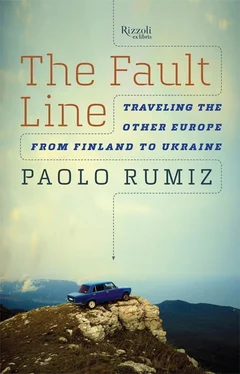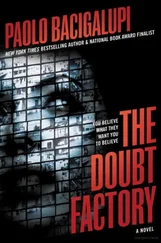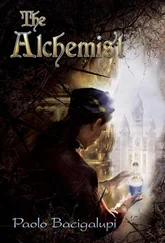It was clear. A bear had gotten inside. “And now all we can do is wait for him to finish,” the Slovenian said, resigned. After a while the brown beast stuck his nose out, surrounded by a cloud of irate bees but nonetheless in a state of ecstasy and totally indifferent to our human presence. He was drunk on honey. He came down the access ladder and staggered back into the woods, followed futilely by the cloud of bees. Adel laughs and mutters, “Yes, that’s exactly how it is.” Try as he might, he can’t bring himself to hate the beast that halves his earnings. The bear, he says, is many animals in one. Like a lion, he downs mammals much bigger than he; like any ruminant, he pillages crops; he steals grapes and fruit like a monkey; nibbles on berries like a blackbird; plunders anthills and beehives like a woodpecker; digs up tubers and larvae like a pig; and catches fish with the dexterity of an otter. And he eats honey like a man.
The frenetic beekeeper finally sits down and takes a break from his incessant activity, but only to talk about bears and honey. One day, I tell him, we saw one at the edge of a clearing shining bright with the first snowfall of the season. He was rocking back and forth and his front paws were making strange signs in the air. It was hard to tell if they were intended as threats or only as a sign of annoyance or anxiety. Then he got back down on all fours and started moving in our direction, still shaking his head. There were three of us, on skis. We had come there from a town on a trail several miles long. Obviously, we didn’t hang around to understand the bear’s intentions. We turned on our tracks and were gone, faster than the wind. We skied for a good twenty minutes without looking back, and the first two in the line never, and I mean never, had time to check if the breathing they heard behind them was a companion or the bear. The last in line, me, logically stayed glued to the end of the train for fear of remaining alone with the beast, and keeping that tight formation we skied faster than we ever had.
Adel laughs at this scene out of a Walt Disney cartoon. I tell him that at the time I laughed, too, once the fear had passed, but I remember that we were all left feeling a mixture of reverential dread, attraction, and a profound sense of mystery, as though we had inadvertently crossed a shadow line. Personally, I became certain of one thing: the bear was now my totemic animal, irritable and cuddly, gluttonous and unpredictable. Since then, my life has been marked by repeated and memorable encounters with bears. I feel them as they are coming back, in this Europe that is going back to the wild and filling back up with woodlands. I follow their movements in Italy, from Abruzzo to the Maritime Alps, to the province of Trent. I’ve seen them migrate to the northwest of Bosnia, escaping from the war and the mines. And here, with the Bashkirian of Karelia, I feel at home. The inhabitants here all have a little bear in them. And the Russian women, unlike their Western counterparts, love their bear-men rather than obedient apartment-dwelling puppy dogs.
I’ve learned in my travels not to ask too many questions. It’s better to talk about yourself. Offer something of yourself and your own story so that the dialogue turns into a bartering of firsts. I tell the beekeeper that in the late 1960s I went to the mountains of Durmitor, in the wild heart of Montenegro, to climb a few mountains, but I came down with a fever and spent two days alone in my tent while my friends went off to climb on their own. In the delirium of 102°, I brought our reserves of food into the tent, without thinking that it would have been better to hang them from a tree limb. That night I woke up to a strange noise and saw the shadow of an animal projected by the moonlight onto the side of the tent. A bear, no doubt about it. It was clear that he was about to come in, so I did the only thing possible. I jumped to my feet yelling and waving my arms in such a way that the whole tent moved, like a specter in the shadows. It worked. The bear disappeared, I hung the food on a tree, and my fever vanished instantly from the fright.
Adel praises the delicacy with which his historical antagonist gathers blueberries, opening his paws like a comb, so as not to ruin the plant. Nobody would ever guess that this same animal, maybe even the day before, had eaten an entire calf, leaving only the skeleton. “Sometimes you can mistake them for men,” he says, “they leave similar tracks in the snow.” Then he jumps to his feet, turns toward the yellow-red line of the hives and asks us to lower our voices. “Hell, I hope it’s not him. A bear comes if you invoke him. That’s what our old folks used to say. A bear is a shaman in disguise.” The Bashkirian walks slowly and stealthily over to the hives. But no, everything is quiet. He looks at his watch and says good-bye. It’s late for the loads of things he has to do. And we leave the house of the bear-man to head back to the house of the wolf-man.
Out on the windswept lake, the hovercraft is going southwest in the middle of a wilderness archipelago with no roads, a place where only the onion domes of the wooden churches, reddened by the setting sun and surrounded by birch trees, tell you that you’re not in Quebec but in Russia, near Finland. Karelia, land of free frontiersmen, land of peasants, poets, and shipwrights exempted for centuries from serfdom because they were effective defenders of Holy Russia.
The Cometa is an enormous sparkling mackerel skimming over the surface of the water, and everything on board—hostess, aerodynamic sheathing, disco music, and whiskey on the rocks—is designed to yank you painfully away from the warm izba s of Velikaya Guba and push you to the West, toward the marmoreal Petrozavodsk—the factory of Peter the Great—which comes into view on the horizon, sleek with Scandinavian order, against the pink evening sky.
On the way, we stop briefly on Kizhi, the island with what is claimed to be the most beautiful wooden church in all of Russia. I would have time to see it, but on the only mooring dock there’s a cruise ship called the Karl Marx . The sacred place has been invaded by American tourists, so we decide instead to enjoy that cathedral of the North from afar, with its architecture that belongs more to Istanbul, Samarqand, or Tabriz than to Warsaw, Hamburg, or Salisbury—places where the perspective direction of our nave doesn’t make sense, because everything is vertical. In Russian churches, you’re not supposed to look toward the “far end” but “up high,” as you do in the Hagia Sophia in Istanbul, a thousand years older than Saint Peter’s in Rome.
One day it happened that the gold, incense, and chants of Byzantium sailed up the Dnieper and the Volga toward the forests of the North. The Christianity of the Greeks, threatened by the advance of the Turks, penetrated inland toward what would become the Third Rome (Moscow), discovered the land of the long shadows, and encountered the great soul of the Russian people. The cross married the birch, and the Byzantine liturgy absorbed from its new world the legends of that salvific wood and the primordial forest. It was then that the icons born on the Bosporus came to know the shipwright and the wood carver’s chisel, acquired relief, lost abstraction, and found rough-hewn corporality. The gleaming gilded tablet had already become sculpture, a ligneous talisman.
The passage to carving was not at all, as some have written, a concession to the illusionistic corporeality of the West. It was a Russian product, which married the hypnotic power of the Byzantine icon to the peasant soul of the land of Rus, made of anthropomorphic masks, dragons, the prows of the longships of the North, or fantastic creatures from the rivers, the woods, or the crops, carved to keep away the cold, famine, and storms. What was born of this wedding were not idols, but holy images of an unimaginable miracle-working force. Today we can see the product of this dazzling contamination: portable churches for travelers; long-bearded saints who agonize sitting down, wrapped in a black mantle; others with swords drawn against dragons or beating the devil with a chain; painted iconostases pullulating with images; patron saints of mountain springs wearing the sweet countenances of matryoshka dolls; royal doors carved with a precision of a Persian bas-relief.
Читать дальше












